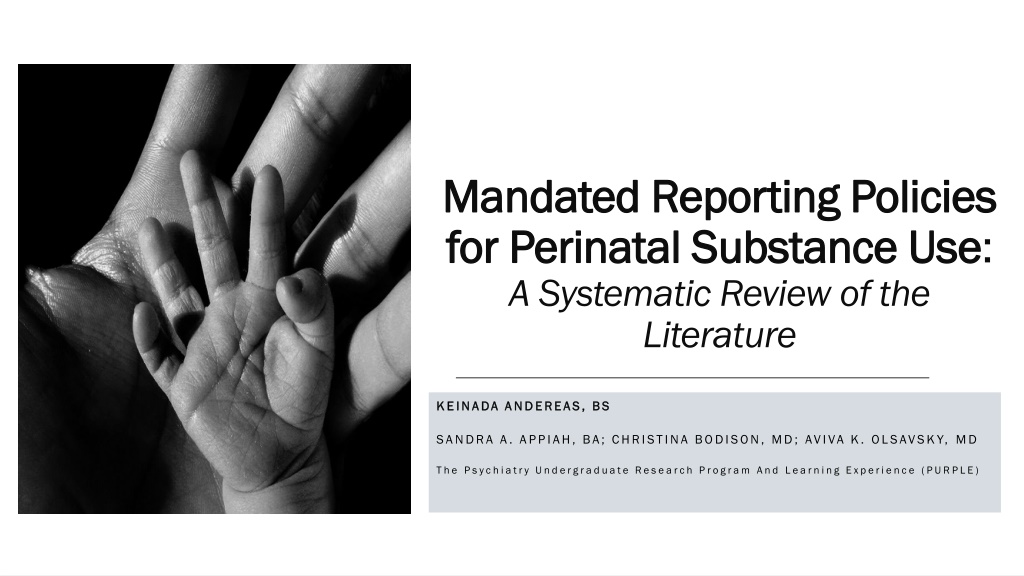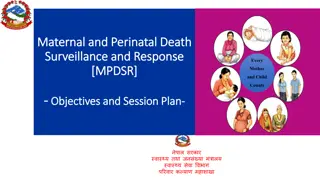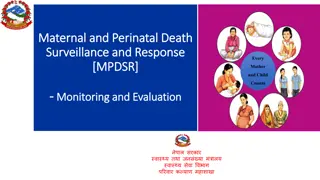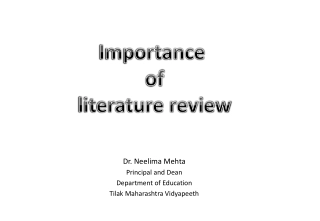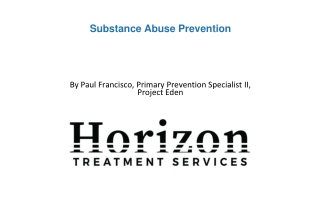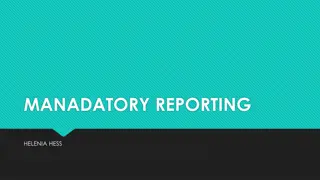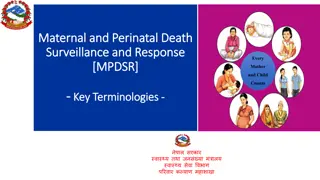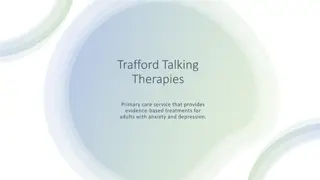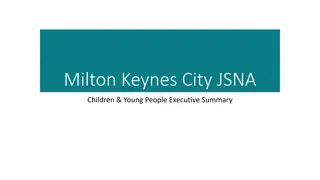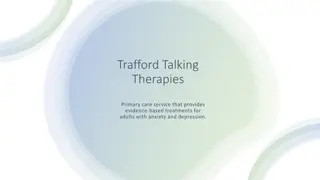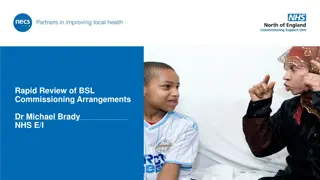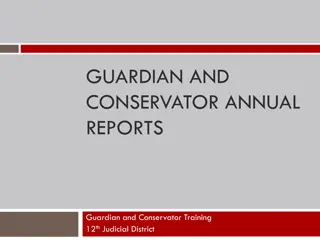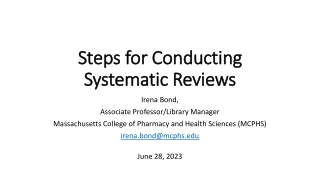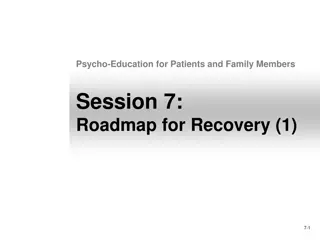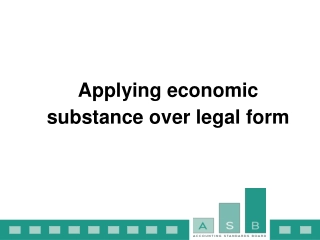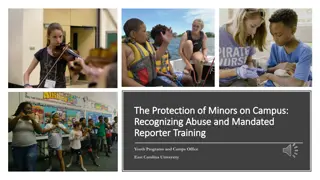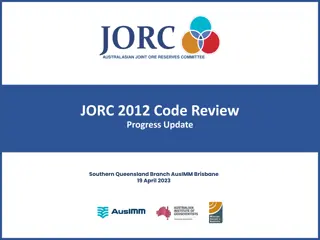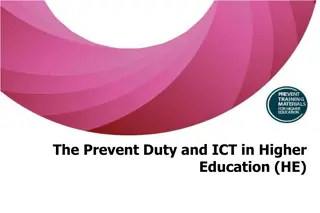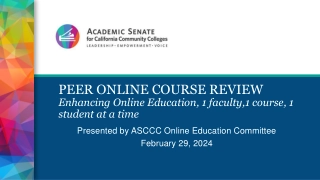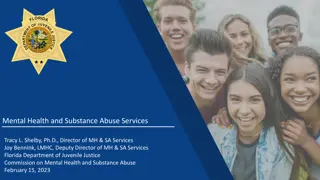Mandated Reporting Policies for Perinatal Substance Use: A Systematic Review of the Literature
This systematic review explores mandated reporting policies in the U.S. concerning perinatal substance use. It highlights the impact of substance use on perinatal and infant health, the disparities in reporting practices, and the need for early interventions to protect vulnerable populations.
Download Presentation
Please find below an Image/Link to download the presentation.
The content on the website is provided AS IS for your information and personal use only. It may not be sold, licensed, or shared on other websites without obtaining consent from the author. Download presentation by click this link. If you encounter any issues during the download, it is possible that the publisher has removed the file from their server.
Presentation Transcript
Mandated Reporting Policies Mandated Reporting Policies for Perinatal Substance Use for Perinatal Substance Use: A Systematic Review of the Literature KEINADA ANDEREAS, BS KEINADA ANDEREAS, BS SANDRA A. APPIAH, BA; CHRISTINA BODISON, MD; AVIVA K. OLSAVSKY, MD T h e Ps yc h i a t ry U n d e rg ra d ua te R e s e a rc h Pro g ra m An d L e a rn i n g Ex pe ri e n c e (PU R PL E)
The first thing [the caseworker] said to me was, So I noticed you were on methadone that's liquid heroin, correct? (31-year-old Black/mixed race mother) methadone. You realize It [methadone] allowed me to have a life. It allowed me to start to work on myself having to have the daily waking up not well every day and starting my day off like that... It gave me the opportunity opportunity. That's what it does. It gives you the opportunity. (33-year-old White mother) Just because I'm on methadone and taking meds, it seemed like everything that happens is always because it's methadone fault I was tired, so that must be not the baby getting up every night, but it must be my methadone. Everything had to do with my meds Everything had to do with my meds. That s how they viewed it. (35-year-old White mother) work on myself without QUALITATIVE QUOTES QUALITATIVE QUOTES - - SCHIFF ET AL, 2022 SCHIFF ET AL, 2022
Mandated Reporting Legally enforceable duty populations to report populations is suspected or confirmed duty for those who have contact with vulnerable report to authorities when mistreatment or abuse mistreatment or abuse of those Identifying and Reporting Child Abuse and Maltreatment/Neglect Child Abuse and Maltreatment/Neglect First enacted in the U.S between 1963-1967 Some laws include any any substance use as reportable neglect Mathews, B. et al (2008). Child maltreatment.
BACKGROUND Women in reproductive years at highest risk for developing a substance use disorder ~5 and 10% of pregnant people use alcohol or other substances (NIDA/NIAAA) In 2017, greater than one-third of children entering foster care due to parental substance use Mandated Reporting is a significant tool in hospitals Early interventions to protect infants Policies vary by state Inequities in mandated reporting Race, ethnicity, SES Forray 2016; Nguemeni Tiako MJ, et al 2022; Meinhofer 2017
OBJECTIVE To perform a systematic review of U.S. mandated reporting literature for perinatal substance use In utero exposure Perinatal and infant health Mandated Reporting Inequities Policies vary
METHODS Search Terms Databases: PubMed, CINAHL, PsycINFO, Cochrane PubMed, CINAHL, PsycINFO, Cochrane Search Strategy: [PARENTAL + {(CANNABIS OR ALCOHOL) + USE}] + REPORTING [PARENTAL + {(CANNABIS OR ALCOHOL) + USE}] + REPORTING
RESULTS (Preliminary) State Legalization of State Legalization of Cannabis Cannabis Policies of mandated reporting vary by state In some states, any use of substance is automatically interpreted as neglect neglect 16 16 14 14 12 12 Treatment engagement not addressed Number of Studies Number of Studies 10 10 Racial/ethnic/SES disparities Racial/ethnic/SES disparities in screening and reporting 8 8 6 6 Most frequently detected: cannabis, cigarettes, and cocaine 4 4 2 2 0 0 Cannabis vs. alcohol treated differently when reporting No No Yes Yes
RESULTS (Preliminary) Type of Study Number of Studies by Year 6 5 21% 4 Cross sectional study 42% 4% Lab test methods study 3 Longitudinal cohort study 29% Policy statements 4% 2 Qualitative research 1 0 1994 1995 1996 1997 1998 1999 2000 2001 2002 2003 2004 2005 2006 2007 2008 2009 2010 2011 2012 2013 2014 2015 2016 2017 2018 2019 2020 2021 2022 2023
CONCLUSIONS Not all evidence-based approaches will likely increase access to care all substance use is necessarily neglect nuanced and Insufficient Insufficient access to high-quality substance use disorder treatment treatment following reporting Prior criminalization of substance use criminalization of substance use perpetuates stigma and makes pregnant and postpartum people less likely to engage with care Promote earlier substance use screening during pregnancy earlier substance use screening during pregnancy (first trimester) to prevent increased substance use There is a need to integrate referral, and treatment processes Motivational interviewing Abstinence only approach vs. harm reduction model integrate our evidence evidence into screening, harm reduction model
FUTURE DIRECTIONS Prospective longitudinal studies Clinical trials of perinatal MI and harm reduction Studies on reporting inequities Advocacy for access to care and decreasing stigma Culturally, sex-, and gender- specific care Culture of safety in obstetric and pediatric clinics
Research Team, THANK YOU! Aviva K. Olsavsky, MD Sandra A. Appiah, BA Christina Bodison, MD SIMBA (Stress in Moms and Babies) Lab PURPLE Mentors and colleagues
QUESTIONS? QUESTIONS?
REFERENCES 1. Forray A. Substance use during pregnancy. F1000Res. 2016 May 13;5:F1000 Faculty Rev-887. doi: 10.12688/f1000research.7645.1. PMID: 27239283; PMCID: PMC4870985. 2. Mathews, B., & Kenny, M. C. (2008). Mandatory Reporting Legislation in the United States, Canada, and Australia: A Cross-Jurisdictional Review of Key Features, Differences, and Issues. Child Maltreatment, 13(1), 50 63. https://doi.org/10.1177/1077559507310613 3. Meinhofer A, Anglero-Diaz Y. Trends in Foster Care Entry Among Children Removed From Their Homes Because of Parental Drug Use, 2000 to 2017. JAMA Pediatr. 2019;173:881-883. 4. Nguemeni Tiako, M. J., & Sweeney, L. (2022). The government s involvement in prenatal drug testing may be toxic. Maternal and child health journal, 26(4), 761-763. 5. Schiff, D. M., Work, E. C., Muftu, S., Partridge, S., MacMillan, K. D. L., Gray, J. R., ... & Bernstein, J. (2022). You have to take this medication, but then you get punished for taking it: lack of agency, choice, and fear of medications to treat opioid use disorder across the perinatal period. Journal of substance abuse treatment, 139, 108765
